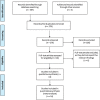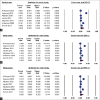Prevalence and Risk Factors of Attention Deficit-Hyperactivity Disorder in the Saudi Population: A Systematic Review and Meta-analysis
- PMID: 37252016
- PMCID: PMC10211419
- DOI: 10.4103/sjmms.sjmms_528_22
Prevalence and Risk Factors of Attention Deficit-Hyperactivity Disorder in the Saudi Population: A Systematic Review and Meta-analysis
Abstract
Objectives: To determine the prevalence and risk factors of attention deficit hyperactivity disorder (ADHD) in Saudi Arabia.
Methods: Observational studies (case-control, cohort, and cross-sectional) that reported the prevalence and risk factors of ADHD among Saudis and were published in English were included. In March 2022, a computerized search was conducted on Medline (via PubMed), Web of Science, and Scopus using keywords associated with ADHD and Saudi Arabia. Two-stage screening and data extraction were performed. The National Institutes of Health Quality Assessment Tool for Observational Cohort and Cross-sectional studies was used for the quality assessment. A random-effects model was used to estimate the prevalence. The Comprehensive Meta-analysis program was used for the analysis.
Results: Fourteen studies (N = 455,334 patients) were included. The pooled prevalence of ADHD in the Saudi population was 12.4% (95% CI: 5.4%-26%). For ADHD-Inattentive and ADHD-Hyperactive presentations, the prevalence was 2.9% (95% CI: 0.3%-23.3%) and 2.5% (95% CI: 0.2%-20.5%), respectively. Regarding the combined AD and HD, the prevalence was 2.5% (95% CI: 0.2%-20.5%). Children of women with psychological disorders during pregnancy (P = 0.043), insufficient vitamin B during pregnancy (P = 0.006), allergic reactions (P = 0.032), and disabling symptoms of muscle pain during pregnancy (P = 0.045) were associated with an increased risk of ADHD.
Conclusions: The prevalence of ADHD in the Saudi population is comparable with that in other countries from the Middle East and North Africa region. Careful monitoring of pregnant women, attention to nutritional sufficiency, psychological and emotional support, and avoidance of stressful events may lead to reducing the incidence of ADHD in the offspring.
Funding: None.
Registration: PROSPERO (Ref no.: CRD42023390040).
Keywords: Attention deficit-hyperactivity disorder; Saudi Arabia; meta-analysis; prevalence; risk factor.
Copyright: © 2023 Saudi Journal of Medicine & Medical Sciences.
Conflict of interest statement
There are no conflicts of interest.
Figures





Similar articles
-
Prevalence and comorbidity of attention deficit hyperactivity disorder in Spain: study protocol for extending a systematic review with updated meta-analysis of observational studies.Syst Rev. 2019 Feb 11;8(1):49. doi: 10.1186/s13643-019-0967-y. Syst Rev. 2019. PMID: 30744675 Free PMC article.
-
Prevalence of attention-deficit hyperactivity disorder in children, adolescents and adults in the Middle East and North Africa region: a systematic review and meta-analysis.BMJ Open. 2024 Jan 18;14(1):e078849. doi: 10.1136/bmjopen-2023-078849. BMJ Open. 2024. PMID: 38238059 Free PMC article.
-
Prevalence of attention deficit hyperactivity symptoms in female schoolchildren in Saudi Arabia.Ann Saudi Med. 2012 Sep-Oct;32(5):462-8. doi: 10.5144/0256-4947.2012.462. Ann Saudi Med. 2012. PMID: 22871613 Free PMC article.
-
Prevalence of attention deficit hyperactivity disorder and comorbid psychiatric and behavioral problems among primary school students in western Saudi Arabia.Saudi Med J. 2018 Jan;39(1):52-58. doi: 10.15537/smj.2018.1.21288. Saudi Med J. 2018. PMID: 29332109 Free PMC article.
-
Epidemiology of attention-deficit/hyperactivity disorder (ADHD) in children and adolescents in Africa: a systematic review and meta-analysis.Ann Gen Psychiatry. 2020 Mar 13;19:21. doi: 10.1186/s12991-020-00271-w. eCollection 2020. Ann Gen Psychiatry. 2020. PMID: 32190100 Free PMC article. Review.
Cited by
-
Assessment of the Quality of Life and Family Function in Attention Deficit Hyperactivity Disorder Caregivers in Al-Ahsa, Saudi Arabia.Cureus. 2024 Sep 25;16(9):e70161. doi: 10.7759/cureus.70161. eCollection 2024 Sep. Cureus. 2024. PMID: 39463622 Free PMC article.
-
The changes of cardiac energy metabolism with sodium-glucose transporter 2 inhibitor therapy.Front Cardiovasc Med. 2023 Dec 6;10:1291450. doi: 10.3389/fcvm.2023.1291450. eCollection 2023. Front Cardiovasc Med. 2023. PMID: 38124893 Free PMC article. Review.
-
New frontiers in pharmacological treatment of attention-deficit hyperactivity disorder.Naunyn Schmiedebergs Arch Pharmacol. 2025 Jun 6. doi: 10.1007/s00210-025-04328-z. Online ahead of print. Naunyn Schmiedebergs Arch Pharmacol. 2025. PMID: 40478337 Review.
-
The Prevalence of Risk Factors Among Children Diagnosed With Attention-Deficit/Hyperactivity Disorder, Aged 4-17 Years: A Cross-Sectional Study.Cureus. 2023 Nov 21;15(11):e49161. doi: 10.7759/cureus.49161. eCollection 2023 Nov. Cureus. 2023. PMID: 38130565 Free PMC article.
-
Exploring Attention-Deficit/Hyperactivity Disorder Symptoms in Patients With Atopic Dermatitis by Disease Severity: Cross-Sectional Analysis.JMIR Dermatol. 2025 Jul 15;8:e74126. doi: 10.2196/74126. JMIR Dermatol. 2025. PMID: 40663791 Free PMC article.
References
-
- American Psychiatric Association. Diagnostic and Statistical Manual of Mental Disorders. Washington, D. C: American Psychiatric Association Publishing; 2022.
-
- Birnbaum HG, Kessler RC, Lowe SW, Secnik K, Greenberg PE, Leong SA, et al. Costs of attention deficit-hyperactivity disorder (ADHD) in the US:Excess costs of persons with ADHD and their family members in 2000. Curr Med Res Opin. 2005;21:195–206. - PubMed
LinkOut - more resources
Full Text Sources
